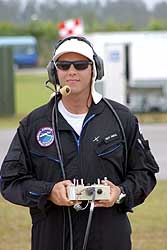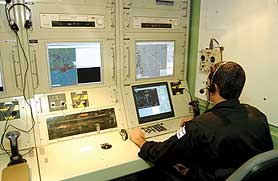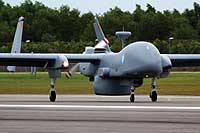Showgoers enjoying the spectacle of the flying display should be aware that at least one of the aircraft is also watching them. It’s IAI-Malat’s big Heron medium-altitude/long-endurance unmanned air vehicle, which was demonstrated yesterday to journalists and representatives of armed forces from the Asia-Pacific region at the Asian Aerospace air show in Singapore.
Heron is packed with sensors, one of them a daytime television camera with a zoom capability powerful enough to reveal the features of individual people on the ground thousands of metres below.
 |  | |
| IAI/Malat's team at the show gave journalists a close-up look at how the Heron operates |  | |
In yesterday’s demonstration the 1,100kg (2,430lb), 16.60m (54ft 6in) wingspan UAV flew an automatic flight profile over the showground as a payload operator in the containerised ground control station beside the runway at Changi air base demonstrated the system’s intelligence-gathering abilities.
Operations
Heron is in operation with the Indian, Turkish and French armed forces and was recently procured by the Israeli Defence Forces. In addition to the daylight video camera, the example flying here carries an infra-red imager for use at night or in bad weather, communications intelligence and electronic support measures (ESM) packages to gather information on enemy emitters, and a synthetic-aperture maritime patrol radar.
Alternative sensor combinations include a synthetic-aperture radar optimised for reconnaissance and a voice relay system for use when the UAV is being flown in civil airspace and co-ordination with air traffic control is needed. According to IAI-Malat, the Heron is the only UAV system in the world to boast such a breadth of capabilities, backed up by ready integration with data-fusion and command and control systems.
After yesterday’s pass over the showground the aircraft flew to the nearby loitering area to demonstrate the Elta EL/M 2022 V2 Maritime Patrol Radar (MPR). Incorporating moving target indication, the radar can spot a submarine telescope at a range of up to 25nm and can track up to 500 hundred targets simultaneously. The even more powerful V3 version, currently in development, can handle up to 2,000 targets at the same time.
The various sensors can be mixed and matched according to conditions and the mission of the moment, and the onboard modules are capable of being swapped out quickly under field conditions.
In one typical mode of operation, the radar would be used for initial target detection before switching to the visible-light camera or infra-red for closer inspection and identification. Alternatively, the ESM and comint packages can silently identify a threat before handing over to the electro-optical sensors.
IAI-Malat is also promoting Heron as a platform suitable for a variety of civilian missions, including pollution detection – the MPR can detect oil slicks – and icefield mapping.
Source: Flight Daily News























